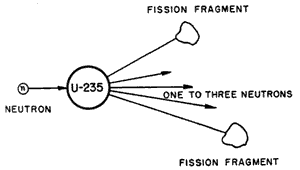DISCOVERY OF URANIUM FISSION
1.52. As has already been mentioned, the neutron proved to be the most effective particle for inducing nuclear changes. This was particularly true for the elements of highest atomic number and weight where the large nuclear charge exerts strong repulsive forces on deuteron or proton projectiles but not on uncharged neutrons. The results of the bombardment of uranium by neutrons had proved interesting and puzzling. First studied by Fermi and his colleagues in 1934, they were not properly interpreted until several years later.
1.53. On January 16, 1939, Niels Bohr of Copenhagen, Denmark, arrived in this country to spend several months in Princeton, N. J., and was particularly anxious to discuss some abstract problems with Einstein. (Four years later Bohr was to escape from Nazi-occupied Denmark in a small boat.) Just before Bohr left Denmark two of his colleagues, O. R. Frisch and L. Meitner (both refugees from Germany), had told him their guess that the absorption of a neutron by a uranium nucleus sometimes caused that nucleus to split into approximately equal parts with the release of enormous quantities of energy, a process that soon began to be called nuclear "fission." The occasion for this hypothesis was the important discovery of O. Hahn and F. Strassmann in Germany (published in Naturwissenschaften in early January 1939) which proved that an isotope of barium was produced by neutron bombardment of uranium. Immediately on arrival in the United States Bohr communicated this idea to his former student J. A. Wheeler and others at Princeton, and from them the news spread by word of mouth to neighboring physicists including E. Fermi at Columbia University. As a result of conversations among Fermi, J. R. Dunning, and G. B. Pegram, a search was undertaken at Columbia for the heavy pulses of ionization that would be expected from the flying fragments of the uranium nucleus. On January 26, 1939, there was a conference on theoretical physics at Washington, D. C., sponsored jointly by the George Washington University and the Carnegie Institution of Washington. Fermi left New York to attend this meeting before the Columbia fission experiments had been tried. At the meeting Bohr and Fermi discussed the problem of fission, and in particular Fermi mentioned the possibility that neutrons might be emitted during the process. Although this was only a guess, its implication of the possibility of a chain reaction was obvious. A number of sensational articles 
were published in the press on this subject. Before the meeting in Washington was over, several other experiments to confirm fission had been initiated, and positive experimental confirmation was reported from four laboratories (Columbia University, Carnegie Institution of Washington, Johns Hopkins University, University of California) in the February 15, 1939, issue of the Physical Review. By this time Bohr had heard that similar experiments had been made in his laboratory in Copenhagen about January 15. (Letter by Frisch to Nature dated January 16, 1939, and appearing in the February 18 issue.) F. Joliot in Paris had also published his first results in the Comptes Rendus of January 30, 1939. From this time on there was a steady flow of papers on the subject of fission, so that by the time (December 6, 1939) L. A. Turner of Princeton wrote a review article on the subject in the Reviews of Modern Physics nearly one hundred papers had appeared. Complete analysis and discussion of these papers have appeared in Turner's article and elsewhere.
-Atomic Energy for Military Purposes, by Henry DeWolf Smyth, 1945